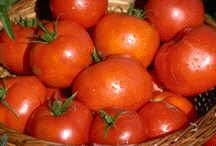|
|
Tomatoes

The
tomato is a plant in the Solanaceae or nightshade family. The taxonomic
name is either Solanum lycopersicum or Lycopersicon esculentum
depending on the reference. Lycopersicon lycopersicum is the common
scientific term for the tomato.
The
tomato is native to the Americas, originating
in South America (it
was initially cultivated by
Aztecs and Incas as early as 700 A.D). Europeans first saw the tomato
when
the Conquistadors reached Mexico and Central America in the 16th
century.
Tomato seeds were taken back to Europe where they quickly found favor
in
the Mediterranean countries of Spain, Portugal and Italy.In the
16th and 17th centuries, many Europeans believed tomatoes were
poisonous because of the plant's relationship to nightshade and
tobacco,
although they were grown as garden ornamentals. It
is now grown world-wide for its brightly coloured (usually red, from
the
pigment lycopene) edible fruits.
The first
traces of use of tomato as food date back to South Europe in
the first half of XVIII century. Only in the second half of XVIII
century cultivation of the tomato as food begins to be widespread,
mainly in southern Italy and in France.
Some
lingering doubts about the safety of the tomato were largely put to
rest in 1820, when Colonel Robert Gibbon Johnson announced that at noon
on September 28,
he would eat a bushel (about 25 kg) of tomatoes in front of the Salem,
Massachusetts courthouse. Reportedly, an immense crowd of more than
2,000 persons gathered in front of the courthouse to watch the poor man
die after eating the poisonous fruits, and were shocked when he lived.
Today,
tomatoes are used extensively in most Mediterranean cuisines,
especially Italian ones. The tomato has an acidic property that is used
to bring out other flavors.
A
study conducted in Italy showed that consuming seven or more servings
of tomatoes a week reduced the risk of developing colon, rectal and
stomach cancer by sixty percent! While lycopene may in fact have many
health benefits, researchers point out that there may be other, as yet
unidentified, substances in tomatoes that make them protective against
diseases, and they say it’s best to get lycopene and other
phytochemicals from foods, rather than from pills or other supplements.
Many
people
believe that tomatoes should be
stored refrigerated. This actually destroys the flavor and texture.
Ideally tomatoes should be stored between 55-65°F at 80-95%
relative
humidity.
One
medium tomato has only 35 calories and supplies 20 percent of
the
daily value for Vitamin A and a whopping 40 percent of the daily value
for Vitamin C. Tomatoes also contain the anti-oxidants p-courmaric and
chlorogenic acids. So eat up and enjoy the flavor and the nutrition!
Other
Related Topics:
|
|
Did You Know?
|
Thomas
Jefferson
was a pioneer in growing tomatoes, beginning in 1809. He grew large
ribbed "Spanish" tomatoes. Jefferson's daughters left numerous recipes
that involved tomatoes, including gumbo soups, cayenne-spiced tomato
soup, green tomato pickles, tomato preserves, and tomato omelettes.
Tomatoes were purchased in 1806 for Presidential dinners. Randolph's The
Virginia Housewife
has seventeen recipes for tomatoes, including gazpacho, gumbo, and
catsup. In an 1824 speech before the Albemarle Agricultural Society,
Jefferson's son-in-law, Thomas Mann Randolph discussed the
transformation of Virginia farming due to the introduction of new
crops. He mentioned how tomatoes were virtually unknown ten years
earlier, but by 1824 everyone was eating them because they believed
they kept one's blood pure in the heat of summer."
By 1850, the tomato was an important produce item in every American
city. People were planting tomatoes in their home gardens, while
farmers
commercially produced fresh tomatoes throughout the year. When cold
weather
halted local production, consumers relied on areas with temperate
climates
to furnish their supply of tomatoes.
|
| Fruit or Vegetable? |
On
the matter of whether a tomato is a
fruit or vegetable, the discrepancy between botany's designation (it's
a fruit) and popular opinion (it's a vegetable) has caused some amusing
results. In 1887,
U.S. tariff laws which imposed a duty
on vegetables but not on fruits caused the tomato's status to become a
matter of legal importance. The U.S. Supreme Court
settled this controversy in 1893,
declaring that the tomato is a vegetable, along with cucumbers,
squashes, beans,
and peas,
using the popular definition which classifies vegetables in how they
are used: they are generally served with dinner and not dessert
Botanically, tomatoes are a fruit. This is because, generally, a fruit
is the edible part of the plant that contains the seeds, while a
vegetable
is the edible stems, leaves, and roots of the plant.
|
|
|